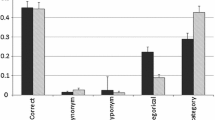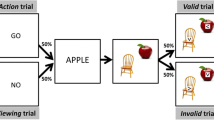Abstract
Extensive evidence has shown that presentation of a word (target) following a related word (prime) results in faster reaction times compared to unrelated words. Two primes preceding a target have been used to examine the effects of multiple influences on a target. Several studies have observed greater, or additive, priming effects of multiple related primes compared to single related primes. The present study aims to eliminate attentional factors that may have contributed to findings in previous studies that used explicitly presented primes and targets. Thus, a continuous priming paradigm where targets are unknown to participants is used with noun-noun-verb triads filling agent, patient, and action roles in situation schemas (tourist, car, rent). Results replicate priming of single nouns preceding related verbs but do not suggest an additive effect for two nouns versus one. The absence of additive priming suggests that attentional processes may have been a factor in previous research.
Similar content being viewed by others
References
Ahrens K. (2003) Verbal integration: The interaction of participant roles and sentential argument structure. Journal of Psycholinguistic Research 32: 497–516
Ahrens K., Swinney D. (1995) Participant roles and the processing of verbs during sentence comprehension. Journal of Psycholinguistic Research 24: 533–547
Balota D. A., Black S. R., Cheney M. (1992) Automatic and attentional priming in young and older adults: Reevaluation of the two-process model. Journal of experimental psychology: Human perception and performance 18: 485–502
Balota D. A., Paul S. T. (1996) Summation of activation: Evidence from multiple primes that converge and diverge within semantic memory. Journal of experimental psychology: Learning, memory, and cognition 22: 827–845
Clark, C. (1997). MRC psycholinguistic database (Version 2.00). [Machine usable dictionary]. Available from University of Western Australia Web site, http://www.psy.uwa.edu.au/mrcdatabase/uwa_mrc.htm.
Coltheart, M. (1981). MRC psycholinguistic database user manual: Version 1. Retrieved February 9, 2011, from http://www.psych.rl.ac.uk/User_Manual_v1_0.html.
Edmonds, L. A., & Mizrahi, S. (2011). Online priming of agent and patient thematic roles and related verbs in younger and older adults. Aphasiology, doi:10.1080/02687038.2011.599527. Retrieved December 1, 2011, from http://dx.doi.org/10.1080/02687038.2011.599527.
Ferretti T. R., McRae K., Hatherell A. (2001) Integrating verbs, situation schemas, and thematic role concepts. Journal of Memory and Language 44: 516–547
Field A. (2009) Discovering statistics using SPSS: Introducing statistical methods (3rd Ed.). SAGE Publications., Ltd., London
Francis W. N., Kučera H. (1982) Frequency analysis of English usage: Lexicon and grammar. Houghton Mifflin, Boston
Gilhooly K. J., Logie R. H. (1980) Age of acquisition, imagery, concreteness, familiarity and ambiguity measures for 1944 words. Behaviour Research Methods and Instrumentation 12: 395–427
Grondin R., Lupker S. J., McRae K. (2009) Shared features dominate semantic richness effects for concrete concepts. Journal of Memory and Language 60: 1–19
Hare M., Jones M., Thomson C., Kelly S., McRae K. (2009) Activating event knowledge. Cognition 111: 151–167
Holm S. (1979) A simple sequentially rejective multiple test procedure. Scandinavian Journal of Statistics 6: 65–70
Jarvis, B. G. (2006). MediaLab (Version 2006.2.40) [Computer Software]. New York, NY: Empirisoft Corporation.
Jones L. L. (2010) Pure mediated priming: A retrospective semantic matching model. Journal of Experimental Psychology: Learning, Memory and Cognition 36: 135–146
Khader P., Scherag A., Streb J., Rösler F. (2003) Differences between noun and verb processing in a minimal phrase context: A semantic priming study using event-related brain potentials. Cognitive Brain Research 17: 293–313
Kučera H., Francis W. N. (1967) Computational analysis of present-day American English. Brown University Press, Providence
McRae K., Boisvert S. (1998) Automatic semantic similarity priming. Journal of Experimental Psychology: Learning, Memory, and Cognition 24: 558–572
McRae K., Ferretti T. R., Amyote L. (1997) Thematic roles as verb-specific concepts. Language and Cognitive Processes 12: 137–176
McRae K., Hare M., Elman J. L., Ferretti T. (2005) A basis for generating expectancies for verbs from nouns. Memory and Cognition 33: 1174–1184
McNamara T. P., Altarriba J. (1988) Depth of spreading activation revisited: Semantic mediated priming occurs in lexical decisions. Journal of Memory and Language 27: 545–559
Merritt P., DeLosh E. L., McDaniel M. A. (2006) Effects of word frequency on individual-item and serial-order retention: Tests of the order-encoding view. Memory and Cognition 34: 1615–1627
Moss H. E., Ostrin R. K., Tyler L. K., Marslen-Wilson W. D. (1995) Accessing different types of lexical semantic information: Evidence from priming. Journal of Experimental Psychology: Learning, Memory, and Cognition 21: 863–883
Neely J. H. (1991) Semantic priming effects in visual word recognition: A selective review of current findings and theories. In: Besner D., Humphreys G. W. (Eds.), Basic processes in reading. Lawrence Erlbaum Associates, Hillsdale NJ, pp 264–336
Nelson, D. L., McEvoy, C. L., & Schreiber, T. A. (1998). The University of South Florida word association, rhyme, and word fragment norms. Retrieved January 21, 2011, from http://web.usf.edu/FreeAssociation/.
Nickels L. (2002) Therapy for naming disorders: Revisiting, revising, and reviewing. Aphasiology 16: 935–979
Paivio, A., Yuille, J. C., & Madigan, S. A. (1968). Concreteness, imagery and meaningfulness values for 925 words. Journal of Experimental Psychology Monograph Supplement, 76 (3, part 2).
Perea M., Rosa E. (2002) The effects of associative and semantic priming in the lexical decision task. Psychological Research 66: 180–194
Raczaszek-Leonardi J., Shapiro L. P., Tuller B., Kelso J. A. S. (2008) Activating basic category exemplars in sentence contexts: A dynamic account. Journal of Psycholinguistic Research 37: 87–113
Rastle K., Harrington J., Coltheart M. (2002) 358,534 nonwords: The ARC nonword database. Quarterly Journal of Experimental Psychology 55: 1339–1362
Sailor K., Brooks P. J., Bruening P. R., Seiger-Gardner L., Guterman M. (2008) Exploring the time course of semantic interference and associative priming in the picture-word interference task. The Quarterly Journal of Experimental Psychology 62: 789–801
Schnur T. T., Schwartz M. F., Brecher A., Hodgson C. (2006) Semantic interference during blocked-cyclic naming: Evidence from aphasia. Journal of Memory and Language 54: 199–227
Setola P., Reilly R. G. (2005) Words in the brain’s language: An experimental investigation. Brain and Language 94: 251–259
Shapiro L. P., Brookins B., Gordon B., Nagel N. (1991) Verb effects during sentence processing. Journal of Experimental Psychology: Learning, Memory, and Cognition 17: 983–996
Thompson C. K., Shapiro L. P., Kiran S., Sobecks J. (2003) The role of syntactic complexity in treatment of sentence deficits in agrammatic aphasia: The complexity account of treatment efficacy (CATE). Journal of Speech, Language, and Hearing Research 46: 591–607
Toglia M. P., Battig W. R. (1978) Handbook of semantic word norms. Erlbaum, New York
Vigliocco G., Vinson D. P., Lewis W., Garrett M. F. (2004) Representing the meanings of object and action words: The featural and unitary semantic space hypothesis. Cognitive Psychology 48: 422–488
Author information
Authors and Affiliations
Corresponding author
Rights and permissions
About this article
Cite this article
Herlofsky, S.M., Edmonds, L.A. Activating Situation Schemas: The Effects of Multiple Thematic Roles on Related Verbs in a Continuous Priming Paradigm. J Psycholinguist Res 42, 1–19 (2013). https://doi.org/10.1007/s10936-012-9206-6
Published:
Issue Date:
DOI: https://doi.org/10.1007/s10936-012-9206-6




